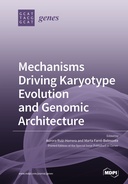Explore

Mechanisms Driving Karyotype Evolution and Genomic Architecture
0 Ungluers have
Faved this Work
Login to Fave
Understanding of the origin of species and their adaptability to new environments is one of the main questions in biology. This is fueled by the ongoing debate on species concepts and facilitated by the availability of an unprecedented large number of genomic resources. Genomes are organized into chromosomes, where significant variations in number and morphology are observed among species due to large-scale structural variants such as inversions, translocations, fusions, and fissions. This genomic reshuffling provides, in the long term, new chromosomal forms on which natural selection can act upon, contributing to the origin of biodiversity. This book contains mainly articles, reviews, and an opinion piece that explore numerous aspects of genome plasticity among taxa that will help in understanding the dynamics of genome composition, the evolutionary relationships between species and, in the long run, speciation.
This book is included in DOAB.
Why read this book? Have your say.
You must be logged in to comment.
Rights Information
Are you the author or publisher of this work? If so, you can claim it as yours by registering as an Unglue.it rights holder.Downloads
This work has been downloaded 160 times via unglue.it ebook links.
- 160 - pdf (CC BY) at Unglue.it.
Keywords
- aberrant sex determination
- adaptation and natural selection
- anophèles
- B-chromosomes
- BAC-clones
- Birds
- centromere
- chromatin state
- chromosomal evolution
- chromosomal polymorphism
- chromosome banding
- chromosome evolution
- chromosome painting
- chromosome rearrangements
- chromosome restructuring
- Chromosomes
- climate change and global warming
- clinal analysis
- comparative cytogenetics
- comparative fish cytogenetics
- comparative genomic hybridization
- Crocidura suaveolens
- cytogenetic
- Cytogenetics
- cytotaxonomy
- Distribution
- dosage compensation
- doves and pigeons
- East Asian cypriniform fishes
- Ellobius alaicus
- Evolution
- faster-X and faster-Z
- fish
- gaur
- genome architecture
- genome biology
- genome organization
- genome organization and function
- genome plasticity
- genomic architecture of sexual development
- habitat specialist
- heterochromatin
- high-throughput sequencing
- karyotype variability
- karyotypic and molecular evolution
- Kirk’s Dikdik
- macrochromosomes
- mandarin vole
- Meiosis
- microchromosomes
- microdissection
- mitotic chromosome
- mosquito
- mtDNA
- musk ox
- n/a
- nilgai bull
- non-homologous chromosome connections
- nucleolar organizing region
- Phylogenetic
- Psophiidae
- Rallidae
- rDNA
- rearrangements
- recombination
- repetitive DNAs
- reptilian vertebrates
- Robertsonian fusions
- Robertsonian translocation
- Robertsonian translocations
- Rodents
- saola
- satellite DNA
- satellite DNA transcription
- sex chromosome
- sex chromosome evolution
- Sex Chromosomes
- sexual antagonism
- Shrews
- snDNA
- synaptonemal complex
- Technology, engineering, agriculture
- Technology: general issues
- translocation
- X chromosome
Links
DOI: 10.3390/books978-3-0365-0157-4Editions

